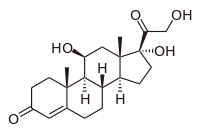
Photo from wikipedia
The amygdala is a key structure involved in both physiological and behavioural effects of fearful and stressful stimuli. The central stress response is controlled by the activity of the hypothalamic-pituitary-adrenal… Click to show full abstract
The amygdala is a key structure involved in both physiological and behavioural effects of fearful and stressful stimuli. The central stress response is controlled by the activity of the hypothalamic-pituitary-adrenal (HPA) axis via glucocorticoid hormones, acting mainly through glucocorticoid receptors (GR), widely expressed among different brain regions, including the central nucleus of the amygdala (CeA). Although to date, neuronal GR was postulated to be involved in the mediating stress effects, increasing evidence points to the vital role of glial GR. Here, we aimed to evaluate the role of astrocytic GR in CeA in various aspects of the stress response. We used a lentiviral vector to disrupt an astrocytic GR in the CeA of Aldh1l1-Cre transgenic mice. Astrocytic GR knockdown mice (GR KD) exhibited an attenuated expression of fear-related memory in the fear conditioning paradigm. Interestingly, the consolidation of non-stressful memory in the novel object recognition test remained unchanged. Moreover, GR KD group presented reduced anxiety, measured in the open field test. However, knockdown of astrocytic GR in the CeA did not affect an acute response to stress in the tail suspension test. Taken together, obtained results suggest that astrocytic GR in the CeA promotes aversive memory consolidation and some aspects of anxiety behaviour.
Journal Title: Behavioural Brain Research
Year Published: 2021
Link to full text (if available)
Share on Social Media: Sign Up to like & get
recommendations!